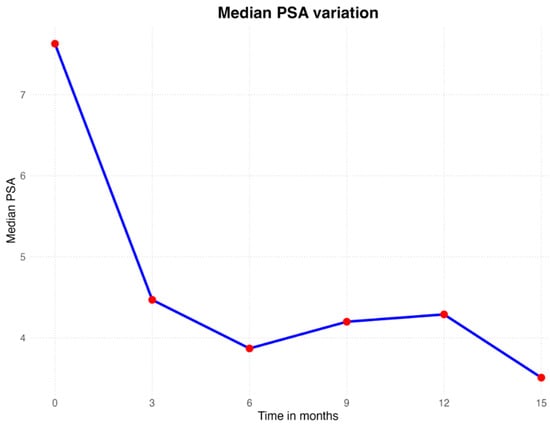Prostate cancer (PCa) is the third-most frequent malignancy after female breast and lung cancer [1]. In 2020, 1,414,259 new cases of prostate cancer were registered worldwide, representing 14.1% of all cancers in men [2]. A striking difference in incidence rates exists in different regions of the world, with the highest age-standardized incidence rates in Ireland (83.4/100,000) and the lowest in South Central Asia (6.3/100,000) [3]. For localized PCa, curative treatments as well as total prostatectomy, external radiotherapy, or brachytherapy are considered the gold standard [4,5,6]. Although the efficacy of these treatments has been demonstrated in high- and intermediate-risk PCa, their value in overall survival or specific survival in the treatment of low-risk cancers is controversial [7,8,9]. An alternative to these curative treatments is active surveillance (AS) but only low-risk PCa is amenable to this mode of management [10]. Recent decades have seen a trend towards earlier diagnosis of PCa because of greater public and professional awareness, leading to the adoption of both formal and informal screening strategies [11,12]. Therefore, PCa is diagnosed while still in the early stages with smaller tumors that occupy only 5–10% of the prostate volume, with a greater propensity for unifocal or unilateral disease [13,14,15]. Nowadays, in these cases, focal therapy has been found to be an effective alternative [16]. The aim of focal therapy is to ablate tumors selectively whilst limiting complications by sparing the neurovascular bundles, sphincter, and urethra [17,18,19]. Most focal therapies have been developed, and they utilize several ablative technologies as well as cryotherapy, High-Intensity Focused Ultrasound (HIFU), photodynamic therapy, electroporation, and focal radiotherapy by brachytherapy or CyberKnife® Robotic Radiosurgery System technology (Accuray Inc., Sunnyvale, CA, USA) [20]. Vascular-targeted photodynamic therapy (VTP) represents one of the new technologies developed in PCa management. This is a minimally invasive technique used for patients with unilateral very-low-risk and low-risk PCa [21]. VTP is characterized by intravenous injection of a photosensitizer locally activated by laser fibers with a specific wavelength of light [22]. This activation produced free radicals that cause a local vascular injury followed by coagulative tissue necrosis [23]. According to previously published studies, it represents a promising treatment option in unilateral low-risk PCa, although a rigorous surveillance strategy is required [24]. In this multicenter retrospective study, we aim to evaluate the safety and efficacy of vascular-targeted photodynamic therapy in low-risk PCa.
Source link
Pietro Saldutto www.mdpi.com

